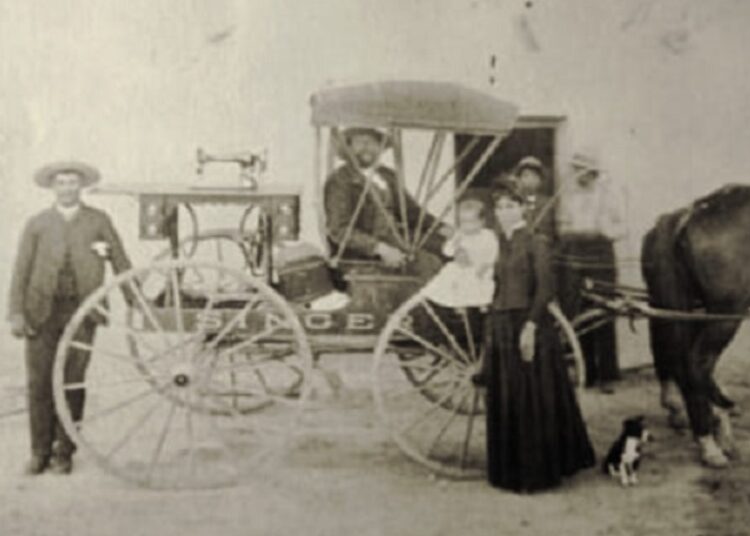Through my grandmother Nancy’s craft, the rhythmic clatter of the sewing machine became the heart of the house. From her sacred corner, her face illuminated by the rays of sunlight filtering through the blinds, she seemed to weave a soft song, a back-and-forth of whispers, with that metal and opaquely varnished wood device. Meanwhile, she transformed scraps of fabric into potholders and tablecloths for Sunday tables, mended school uniforms or sewed all kinds of clothes for her brood of grandchildren. As a child, I had no better clothes than those born from that magical complicity between my grandmother and her old sewing machine.
Even though the traditions of yesteryear are endangered species and the robotic mind has forgotten the value of handmade items, in almost every Cuban home our grandmothers and mothers have used or still use the Singer sewing machine. Every family history has also been woven with those stitches that remain like sutures of time, of the dreams and sacrifices of generations of women who saw the needle rise and fall a thousand times in the effort to stitch together a world with less holes for their loved ones.
The sewing machine is a domestic symbol of struggle, selflessness and silent hope. A long thread of life. In many cases, it has marked the rhythm of an existence stigmatized by the necessity that sharpens ingenuity.
My mother and one of my aunts followed my grandmother’s lead. The Singer is still preserved as a family heirloom that has endured with solemn dignity the ravages of decades of use. The piece of furniture is made of iron and wood: approximately 120 centimeters long, 100 centimeters high and 38 centimeters wide. The cabinet is dark brown, with an extension table, two drawers on each side, and a long one in the center. It rests on two decorated iron legs. It is operated by a pulley. It has a rocker pedal, equally decorated, and a support bridge with the brand’s logo. The mechanical arm is black and notched, and although barely visible, it is noticeable that it once had filigree and gold lettering with the inscription: SINGER. Although it no longer displays its original splendor, the echo of its song is present to remind us that each stitch wove something of our roots.
First enduring “household appliance”
On August 12, 1851, Isaac Singer, a man of dissolute life who combined theater with his inventive and entrepreneurial spirit, managed to patent his prototype of a “reformed” sewing machine. By then, the machine had actually already existed. Elias Howe had introduced it five years earlier. So the patent registered by Singer was the final straw in the so-called “sewing machine wars,” in which both manufacturers vied to be the epitome of progress.
Singer certainly worked on Elias Howe’s model to launch his new design; but the turning point for the founder of the Singer Sewing Machine lay in the mechanical leap that included: a right-angled arm that allowed horizontal fabric handling and straight-line sewing; a pedal that provided greater control and speed to the operation; and a vertically moving needle that improved stitch consistency and quality. Added to this was the ease with which the machine could be adapted to the home — even as a decorative table, for folding machines — and a clever marketing strategy that would become a standard-bearer: installment payments.
Traversed by sexist conceptions of gender and social class, at that time most wives and daughters were forced to practice sewing. Above all, they did it by hand. It was Penelope’s never-ending task. That’s why the press came to proclaim the sewing machine one of the greatest inventions in history; for no other advance, they said, had brought such great relief to “our mothers and daughters.”
When it burst onto the market, Isaac Singer’s creation exponentially surpassed the Jenny Lind model, the most famous until then. In less than ten years, the Singer Company managed to revolutionize the textile industry, controlling two-thirds of the global sewing machine market and establishing itself as one of the first multinational corporations in the United States.
According to data published by the Diario de la Marina, by early 1888 there were eight million Singer machines distributed worldwide, while the corporation employed 30,000 people and had six large factories located in New York, Cairo, Vienna, South Bend, Montreal and Glasgow, producing one million units annually.
A century later, this sewing machine — which modernized its models over the years — was still recognized as the most innovative, versatile, efficient and prestigious. It became what we might call the first iconic and enduring “household appliance.”
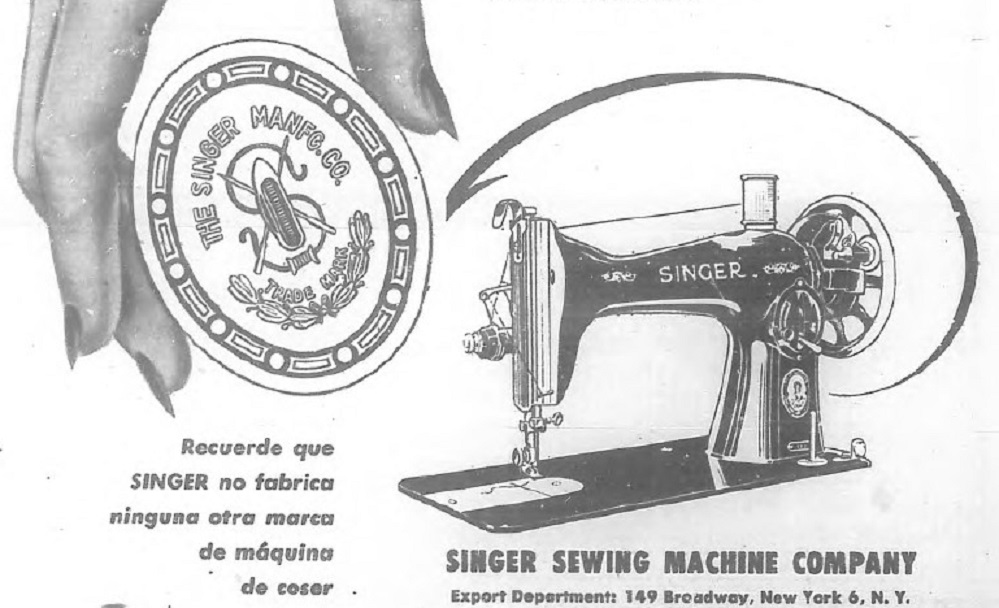
It was located on Obispo Street
The time for Singer sewing machines dawned in Cuba in the late 1850s, when the Company showed interest in the Caribbean market and set up an agency in Havana. Eduardo H. Stanton was one of the first to open a warehouse for such purposes at 64 Obispo Street, the city’s commercial artery. A year later, the concession and the premises were managed by Antonio de Sotolongo, and the following year the franchise passed into the hands of American Silas Daily, who decided to move the store to 125 Obispo Street.
However, due to the obvious instability of the franchisees, and mainly because it had to overcome competition from other established brands such as Wertheim and Grover & Baker, it would take Singer five years to win over Cuban customers. It wasn’t until the emergence of Ramón Álvarez de Arribas that the brand managed to embroider its reputation on the island with golden thread.
He was barely 14 years old when he decided to leave behind the rural hardships of his native Peón, in Asturias, and board a transatlantic ship to Cuba with the hope of making his fortune. To his eyes, accustomed to the village valley, Havana seemed like an unreal world. He was impressed by the environment of rapid economic growth, the movement of goods, technological advances and ethnic diversity.
After many efforts and vicissitudes, Ramón, the archetype of the Spaniard of his time, an entrepreneur and visionary, set his sights on founding his own business. “We don’t know how, but around 1866 — thirteen years after arriving in Cuba — he managed to gather the knowledge, contacts and capital necessary to start his own company. Under the name Gutiérrez y Álvarez, he obtained a license from the Singer Manufacturing Company to exclusively market its sewing machines in Cuba and Puerto Rico,” writes Spanish author Cristina Cantero Fernández in her book, Un legado indiano para el siglo XXI. Ramón Álvarez de Arriba (1839-1920), an exhaustive biographical study that clears up the confusion that surrounded this historical figure for a century.
“For now,” the researcher, who was able to consult the Singer Company archives, maintains in her account, “the beginnings of Gutiérrez y Álvarez are quite uncertain, and we don’t even have information about Ramón’s partners, beyond the manager’s last name. It’s likely that they worked in one of the aforementioned Singer stores or in businesses on Obispo Street, where they experienced the possibilities of this franchise. It’s conceivable that Gutiérrez was the oldest partner with the most experience in the sector, hence his assumption of management of the firm, but little more can be speculated. Perhaps Ramón was also familiar with sewing machines or learned everything he needed to know about them from his partners. In any case, Gutiérrez, Álvarez & Co. managed to make the Singer brand one of the best-selling brands in the Cuban market.”
An advertisement that appeared in the Diario de la Marina from September 24 to December 18, 1874, confirms this: “5,000 machines sold in our company last year attest to their superiority!”
Despite the aforementioned sales boom, the partnership dissolved after a few months, and Álvarez e Hinse was born, the new branch established by Ramón and the American Herman George Hinse — nine years his junior — which opened at 123 and 125 Obispo Street as a warehouse and retail store for miscellaneous supplies.
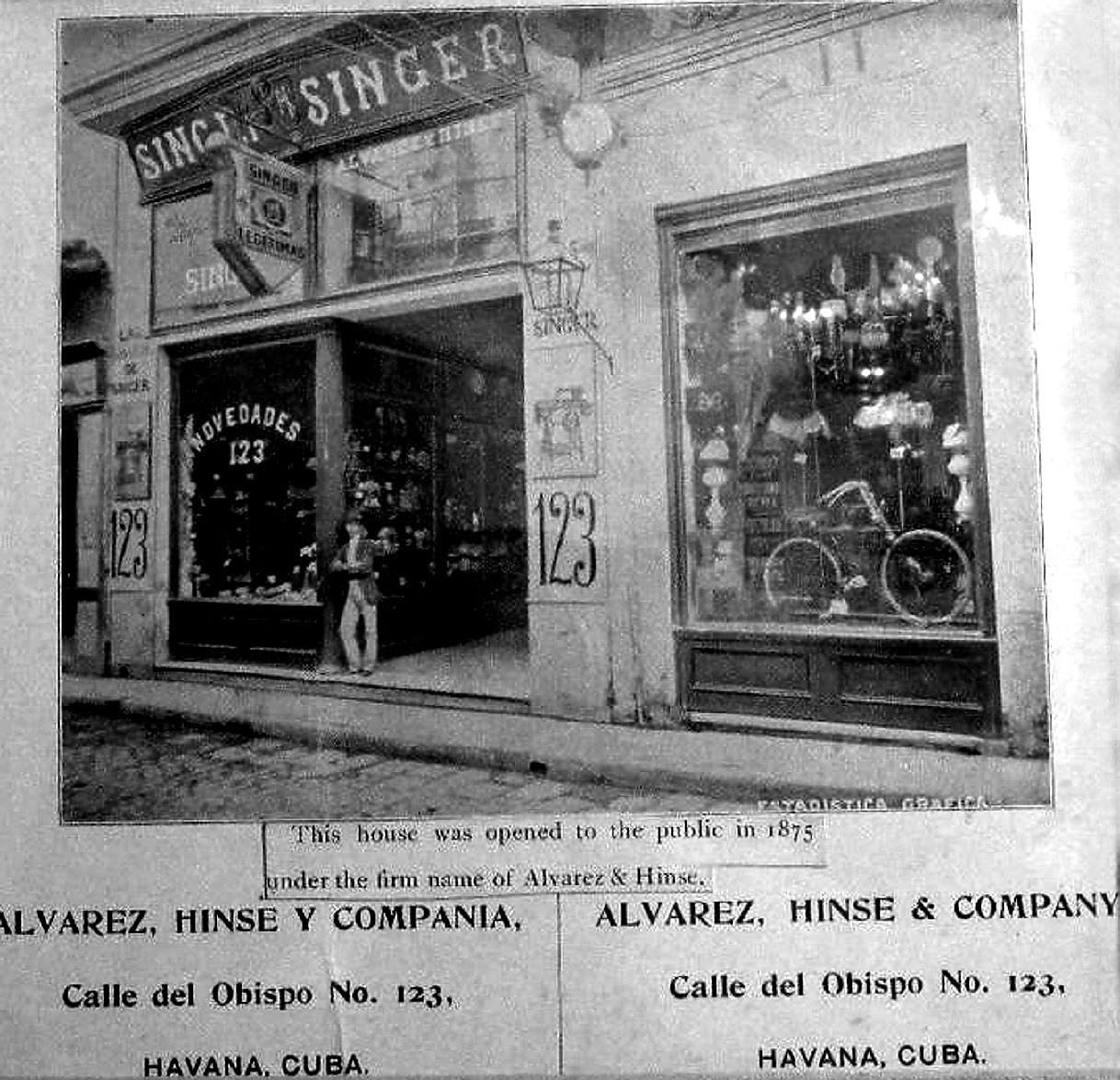
The queen of sewing machines
Ramón and his partner would later add cutlery, watches, and hardware to their business, among other items. Under the sales premise of “a lot of good, beautiful and inexpensive things,” they became known as the Grand Bazaar of Sewing Machines and New Items.
As sole representatives and importers of the Singer Company, Álvarez and Hinse amassed a considerable fortune and, within two years, controlled 90% of the domestic market; largely aided by the fact that demand for sewing machines in Cuba exceeded that of other countries.
In a report letter dated November 7, 1887, sent to the parent company, Ramón Álvarez explained: “Perhaps there is no other country that, in proportion to its population, sells as many sewing machines as Cuba…. Sewing machines of all kinds are sold in every city and town, large or small. There is no establishment specializing in them; they are sold like any other merchandise, quite naturally, in department stores, hardware stores, grocery stores, etc., throughout the length and breadth of the island.”
At the end of the 19th century, a Singer sewing machine meant to housewives what a Smith & Wesson revolver meant to men. Although all would dream of owning one, logically not everyone could afford one, so at the time it also represented a measure of socioeconomic status.
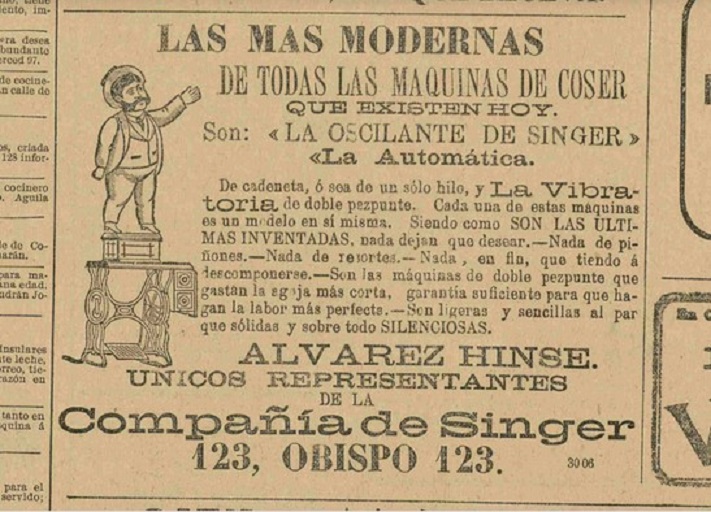
Convinced of the power of advertising as a marketing technique to establish a brand and increase revenue — something commonplace today, but still in its infancy at the time — Álvarez and Hinse tirelessly promoted in the press the incomparable quality of their “mechanical marvels” and the “bargains” they offered for their purchase. In this regard, they declared: “Ready to please everyone, we will sell these machines from now on at fabulously cheap prices.” Well paid, the Diario de la Marina joined in the chorus, claiming that the Reformed Singer, the Vibratory, the Automatic, the Oscillating… — that is, the main models marketed by the brand — ”will be the obsession of sewing machines.”
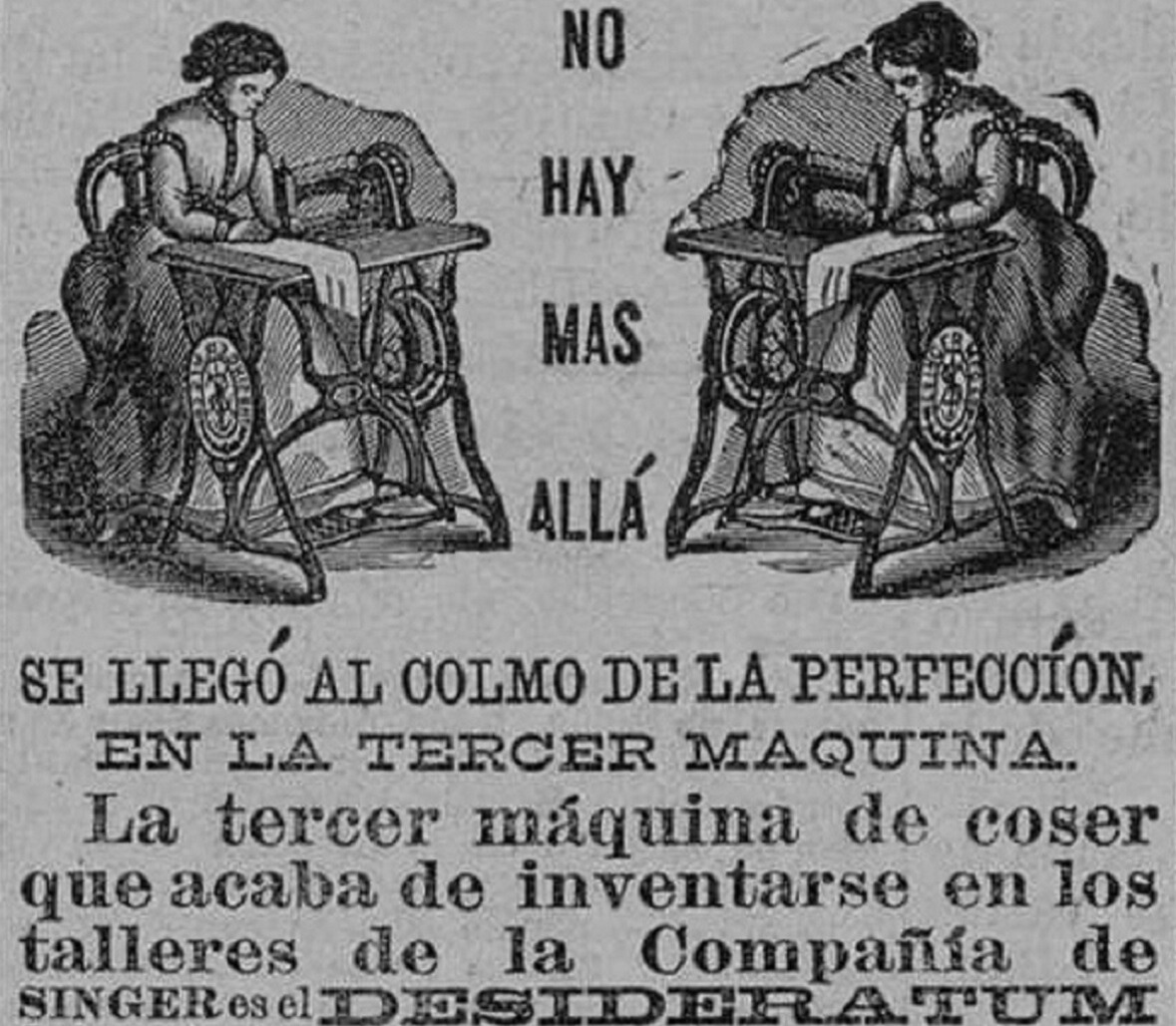
Furthermore, the official publication of the Havana Post Office described them as the “Non-Plus-Ultra of sewing machines” or “the most perfect known to date.” In line with this, it called for “making way for the Queen of sewing machines.”
On February 19, 1888, the newspaper noted: “The Singer company does not rest on its laurels; it lives the active life of progress, and the proof is known to all who follow in its footsteps. Today, as always, it is ahead of all, and imitators will never be able to stop its march.”
Stitches that have marked eras
After the end of the war, the socioeconomic situation in Cuba was dire, so many women and widows found in the sewing machine a way to feed their children. Meanwhile, the arrival of the 20th century found the old company founded by the Asturian transformed into Álvarez, Cernuda y Cía., a limited partnership established with Celestino Cernuda Peláez in the spring of 1900. By then, they were operating as a novelty bazaar specializing in sewing machines.
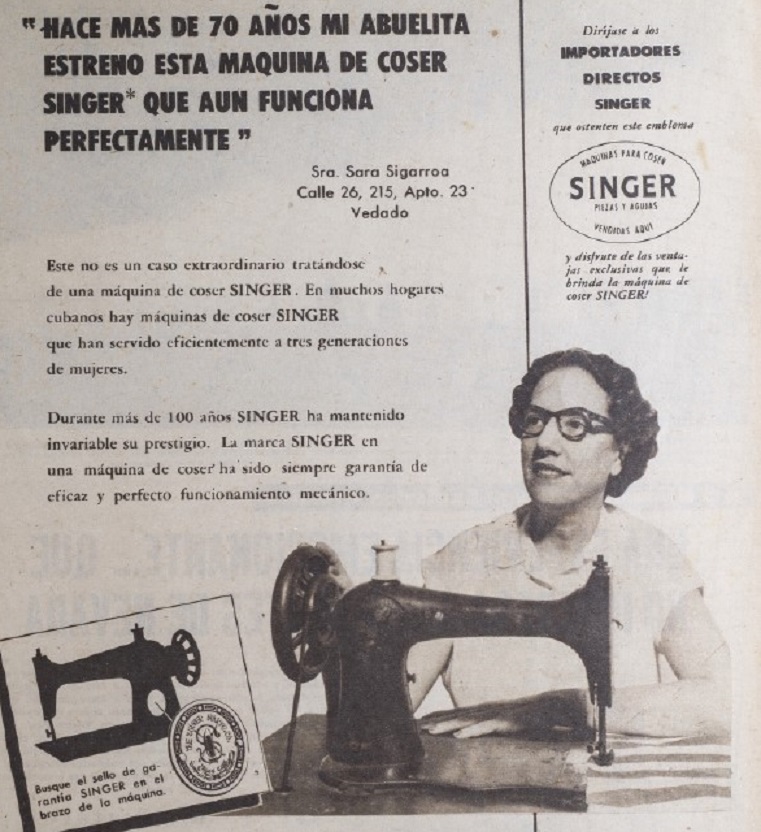
With Ramón’s intact keen eye for detecting business opportunities and a commercial strategy focused on subaltern groups, during the Republican era the Singer empire continued along similar lines to its predecessor, maintaining its suppliers and sales policy at affordable prices and on credit (payments could be made with a down payment of one peso and up to 40 months), but constantly updating the business dynamics and the mechanics of its prototypes. Simply put, it continued to expand its hegemony.
“In every language, Singer means the same thing: the best sewing machine in the world,” proclaimed a Bohemia advertisement in June 1954. As the brand’s advertising platform until the early 1960s, the renowned magazine was tasked with convincing its readers that Singers were “the last word” when it came to sewing machines and that “when you buy a Singer sewing machine, you know it will provide you with efficient service for a lifetime.”
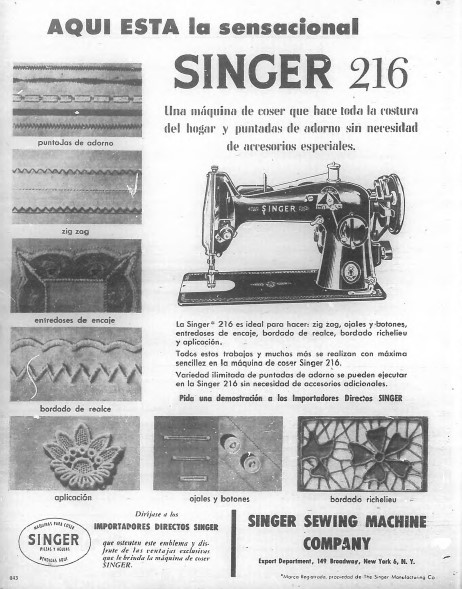
Let the seamstress sew.… Those who have plenty to say about it will tell me whether or not this is less true than the Singer time machine. A legacy of traditions and a testament to the spirit of Cuban women, who, with Penelope’s obsession, overcomes so many odysseys, maintains the same fame as before, in its everlasting capacity to weave together those stitches that have marked eras.

